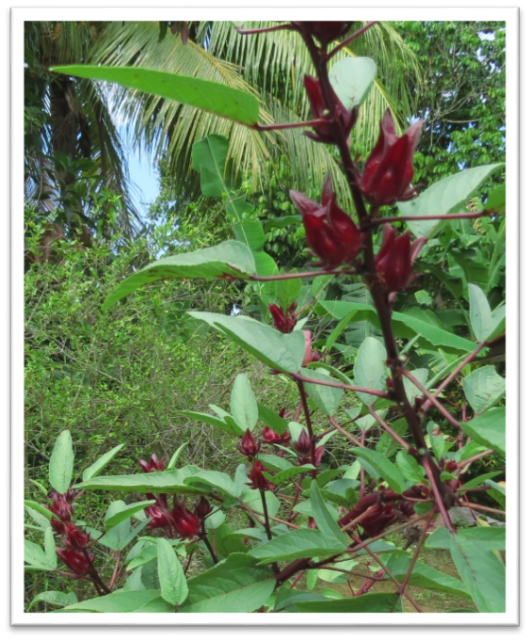 On a recent trip to my mother-in-law’s house in Terengganu, Malaysia, she introduced us to a plant called Roselle. Norlela’s mother had planted the flowering shrub near the house to pick the succulent, dark red flowers that sprout along the branches. Roselle belongs to a hibiscus group, a genus of flowering plants in the mallow family. The woody-based shrub that grows between 2 to 2.5 meters tall.
On a recent trip to my mother-in-law’s house in Terengganu, Malaysia, she introduced us to a plant called Roselle. Norlela’s mother had planted the flowering shrub near the house to pick the succulent, dark red flowers that sprout along the branches. Roselle belongs to a hibiscus group, a genus of flowering plants in the mallow family. The woody-based shrub that grows between 2 to 2.5 meters tall.
To my mother-in-law and others around the area, this plant provides a cooling drink on a hot day or sweet, tangy jam. It is a simple 5-step process to gather and prepare a week’s supply of homemade drink “mix” and jam.
Step #1 – Gathering Has Its Hazards
Mak, the Malay word for Mom, tasked Norlela and me to pick the biggest flowers. Armed with a colander and kitchen shears, we trudged outside, sweating in the tropical heat and 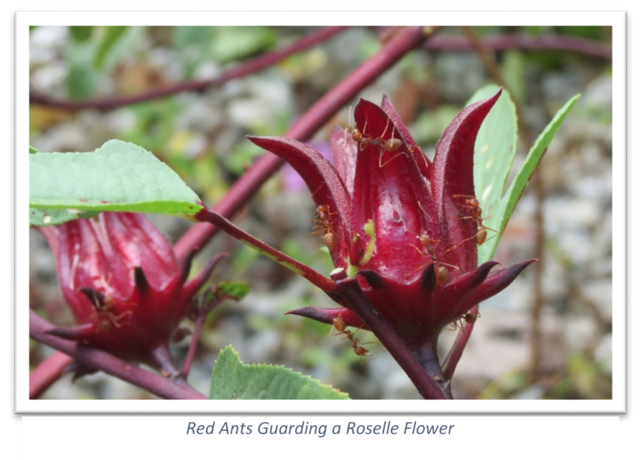 started snipping off the biggest blossoms. One thing to keep in mind in tropical areas is the amount and variety of insects that live here. In particular, red ants. These little monsters make their home in any tree or bush where they can sew together a few broad leaves to make a baby factory. They are aggressive, fast, and they hurt. Of course, they had their nest in the same bush, we were working in and were guarding it fanatically. Norlela snipped buds, and I brushed ants.
started snipping off the biggest blossoms. One thing to keep in mind in tropical areas is the amount and variety of insects that live here. In particular, red ants. These little monsters make their home in any tree or bush where they can sew together a few broad leaves to make a baby factory. They are aggressive, fast, and they hurt. Of course, they had their nest in the same bush, we were working in and were guarding it fanatically. Norlela snipped buds, and I brushed ants.
Our colander full, we marched back inside to show our stash to Mak proudly. “Not enough,” she declared, and we forced to go back out to battle the ants for another bowl full.
Step #2 – Separating the Flower from the Seed Pod (Roselle Capsule)
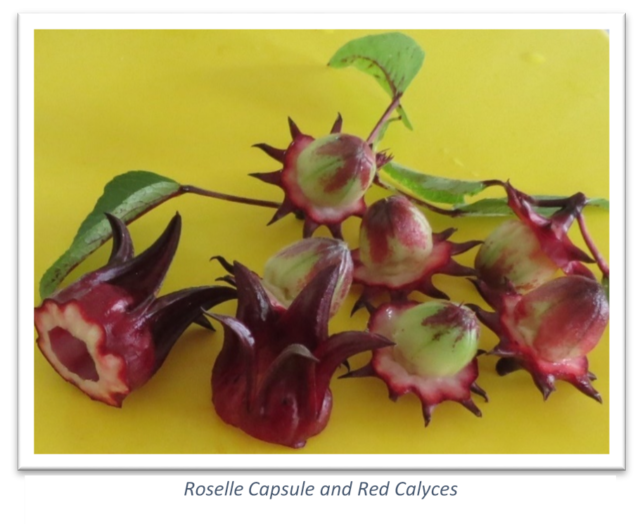 The reason we need more is that we only use the outer red flowering part, not the thick inside seed pod. Mak showed us how to cut around the base of the flower and pop out the capsule. It has the consistency of thin asparagus without the fibers. The juice is as red as beet juice and stains everything it touches too.
The reason we need more is that we only use the outer red flowering part, not the thick inside seed pod. Mak showed us how to cut around the base of the flower and pop out the capsule. It has the consistency of thin asparagus without the fibers. The juice is as red as beet juice and stains everything it touches too.
According to Wikipedia – The red calyces of Roselle are increasingly exported to the United States and Europe, notably Germany, used as food colorings.
Step #3 – Wash Your Troubles Away
The next step is to wash the flowers; Norlela sprinkled some coarse salt in the water, a common practice to remove any dirt and hitchhikers. The tropics are an entomologist’s dream, and the salt helps drive tiny insects to the surface. The salt also has an antimicrobial effect. We rinsed everything twice.
Step #4 – Boil and Add Plenty of Sugar
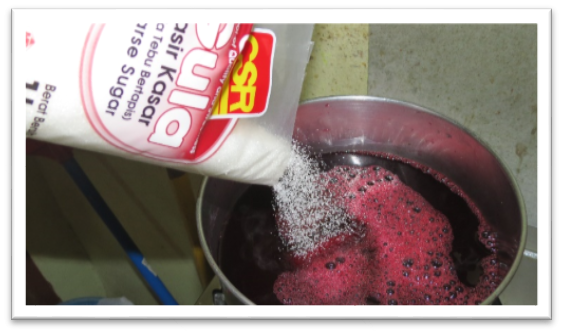
The flowers simmer in a large amount of water (4 to 1 by volume) to extract the color and flavor. They simmered for about 30 minutes and then we added copious amounts of sugar. It’s eyeballs and instinct, no Food Network recipe here. I would guess about 2 pounds of sugar for a half gallon of water. Simmer for another 15 minutes.
Step # 5 – Strain and Use Everything
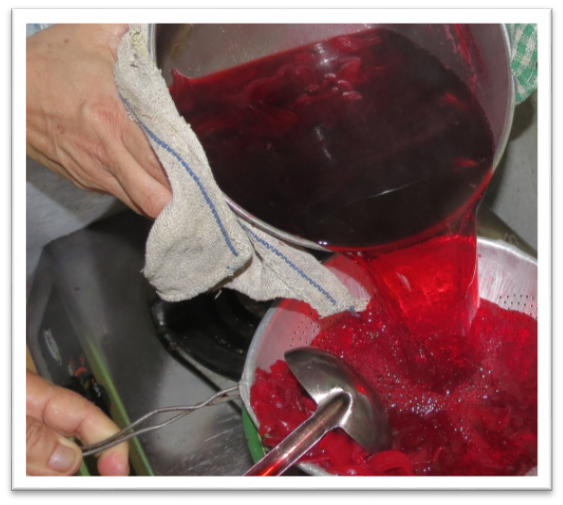
We strained the contents of the pot through a fine colander, cooling the syrup which we later bottled in a used soda bottle and stored in the refrigerator. The boiled flowers were pureed in the blender then reduced with more sugar and some of the syrup until thickened. We packed the resulting jam into a “recycled” jelly jar.
From years of living with little, nothing goes to waste in this house, not even old jelly jars.
What Does Roselle Taste Like?
Roselle is typically served as a syrup, mixed with chilled water and drunk with a meal as a refreshing change from tea or plain water.
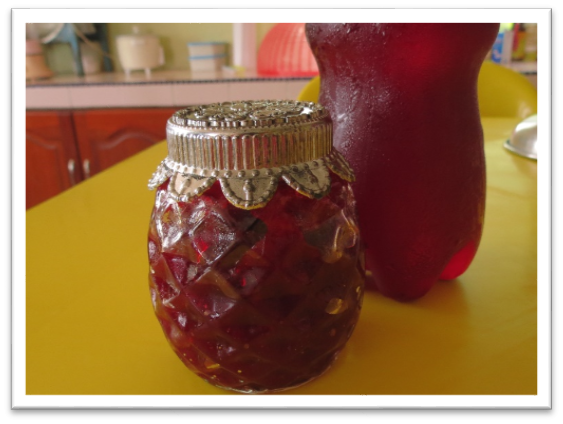
Without sugar, it is very sour. As sour as lemon without the lemon flavor. Roselle has a hint of tart cherry but is not fragrant. Roselle jam tastes like plum jam but more acidic. I think people like it mainly for the intense red color and of course, the sugar.
Roselle is New to Me but Popular Around the World
Just when I thought I was special from making a drink from a wild plant, Norlela burst my bubble by telling me to do my research. Here it is in a nutshell. Anywhere it never snows, Roselle grows.
Roselle has been cultivated for centuries in Africa and has spread to every sub-tropical and tropical region around the world. It is an excellent source of vitamins C & A. It is loaded with Calcium, Potassium, Magnesium and Phosphorus too.
I found out that these sweet drinks are popular around the globe in social events, often mixed with mint leaves, dissolved menthol candy, and/or fruit flavors. Chilled Roselle syrup makes a colorful mixer for adult holiday beverages.
The thin woody branches have fiber used to make burlap and the roots are brewed for diuretic and mild laxative in some countries. The leave tastes like a sour version of spinach and can add flavor to fish and rice dishes. I ate one right off the plant, and it has a tangy sour flavor that would make a good tea or flavoring. Tea makers use the Roselle buds as a cheap substitute for berry flavored teas.
The next time you see a drink or tea flavored with Roselle, give it a try. It is a healthy alternative (minus the sugar) to typical sodas or drink mixes.
